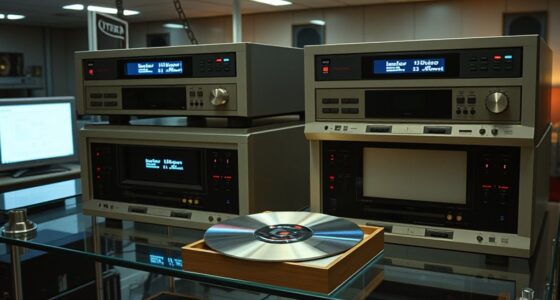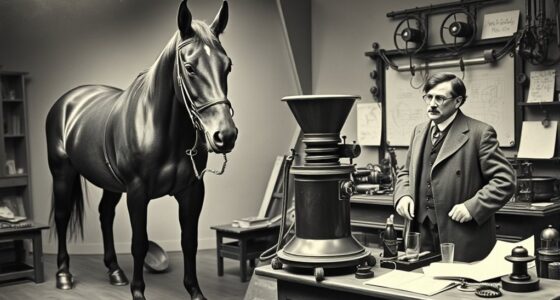Home heating evolved from simple fireplaces to modern smart thermostats that give you precise control and efficiency. Early homes relied on fireplaces and hearths made of durable materials, while stoves in the 18th and 19th centuries offered more consistent warmth. Innovations like central heating, electric systems, and smart technology transformed comfort levels. If you stay tuned, you’ll discover how these advancements continue to shape the future of warm, eco-friendly homes.
Key Takeaways
- Early homes relied on open fireplaces and hearths made of durable materials like stone and brick for heat and social gathering.
- Wood and coal stoves replaced fireplaces, offering more efficient, controlled heating and enabling urbanization during the 18th and 19th centuries.
- Central heating systems, including radiant and geothermal options, revolutionized home warmth with improved efficiency and sustainability.
- Modern HVAC technology introduced zone control, smart thermostats, and remote management for enhanced comfort and energy efficiency.
- Future trends focus on integrating renewable energy sources and smart automation for eco-friendly, precise, and convenient home heating solutions.
Early Fireplaces and Hearths
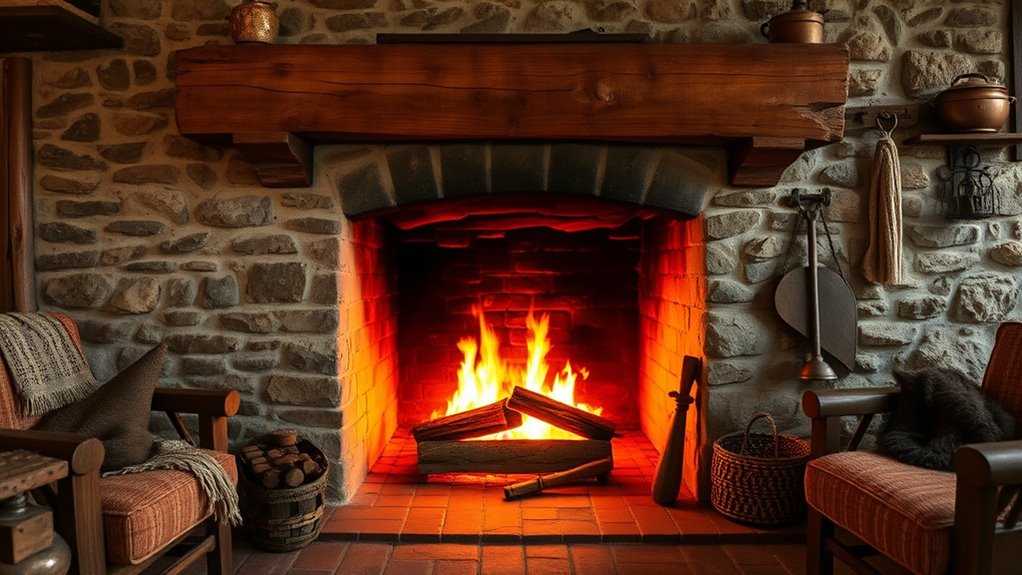
Early fireplaces and hearths marked the beginning of home heating, serving as the central feature in most households. Their fireplace design focused on maximizing heat output while accommodating the available space. You’ll notice that hearth materials varied, with stone, brick, and clay being common choices. These materials were chosen for their heat retention and durability, helping to contain the fire and prevent accidents. As you study early hearths, you’ll see that their simple construction prioritized practicality over aesthetics, yet they became the heart of family life. Fireplaces were essential for warmth, cooking, and social gatherings. Over time, the design evolved to improve efficiency and safety, but their core purpose remained unchanged: providing heat and comfort to households. Understanding the evolution of hearth materials and design can offer insights into the development of home heating technology.
The Rise of Wood and Coal Stoves
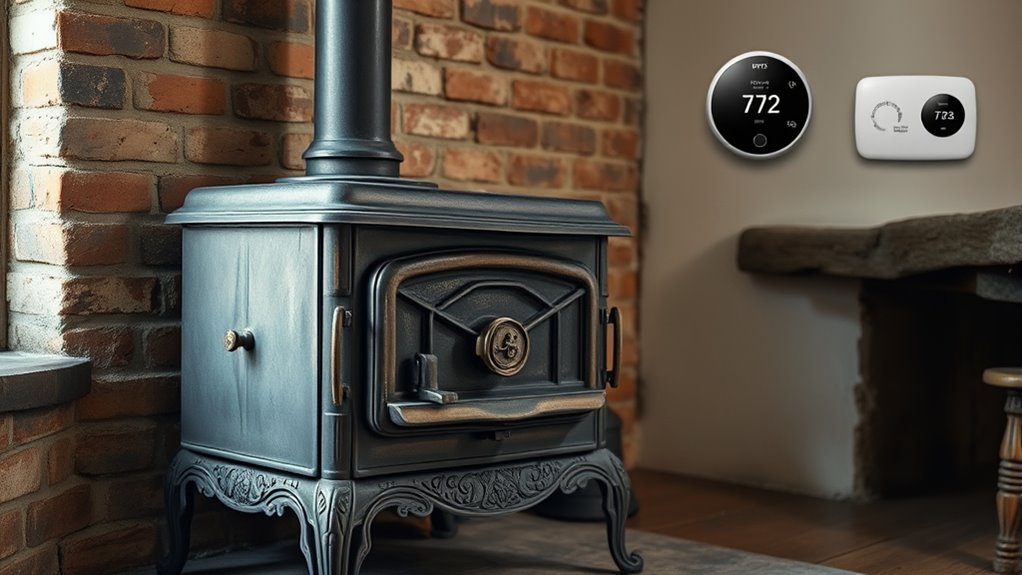
You’ve seen how early heating methods relied on simple fireplaces, but wood and coal stoves changed the game. Wood stoves became popular because they provided more efficient and controlled heat. Coal stoves then made a big impact, offering even greater warmth and transforming home heating practices.
Early Heating Methods
How did people keep warm before modern heating systems emerged? They relied on simple yet effective methods like wood and coal stoves, which became popular in the 18th and 19th centuries. These stoves were placed centrally in rooms, with radiator placement carefully considered to maximize heat distribution. Proper insulation techniques, such as thick walls and heavy curtains, helped retain warmth and improve efficiency. Homes often featured fireplaces for additional heat, but stoves offered a more controlled and cleaner way to generate warmth. As technology advanced, these early methods laid the groundwork for more sophisticated heating systems. IRA investment strategies played a role in funding innovations that improved heating technology and distribution. Despite their simplicity, they considerably improved comfort and set the stage for future innovations in home heating.
Popularity of Wood Stoves
As homes sought more efficient ways to stay warm, wood and coal stoves gained widespread popularity in the 18th and 19th centuries. The rise of wood stove popularity was driven by their ability to provide more consistent and controllable heat compared to open fireplaces. These stoves improved heating appliance efficiency by directing heat where it was needed most, reducing heat loss and making indoor spaces warmer for longer periods. Their compact design also made them easier to install and use. As a result, wood stoves became a preferred choice for many households, especially in rural areas, where access to other fuel sources was limited. This shift marked a significant step forward in home heating technology, paving the way for further innovations in heating appliances. Additionally, the adoption of efficient heating solutions like wood stoves contributed to greater comfort and energy savings for homeowners.
Coal Stoves’ Impact
The rise of coal stoves marked a significant advancement in home heating, especially during the 19th century. They greatly impacted urbanization by enabling cities to efficiently heat larger buildings and homes, fueling population growth in industrial centers. However, this shift also brought environmental consequences. Burning coal released smoke, soot, and pollutants, contributing to air pollution and health problems in densely populated areas. While coal stoves made heating more reliable and accessible, they also intensified urban smog and environmental degradation. As you consider this period, you’ll see how coal stoves transformed daily life and city landscapes, but also introduced new challenges related to pollution and ecological health. Their impact underscores both technological progress and the need for environmental awareness. The use of pollutant emissions from coal stoves played a crucial role in shaping environmental policies later in history.
Innovations in Central Heating Systems

Innovations in central heating systems have revolutionized the way homes stay warm, making them more efficient, convenient, and environmentally friendly. Modern options like radiant heating provide heat directly through floors or walls, reducing energy waste. Geothermal systems tap into the earth’s stable temperature, offering sustainable warmth with low operating costs. These advancements improve comfort while decreasing carbon footprints. Additionally, the integration of smart technology allows for remote monitoring and control, further enhancing energy efficiency and user convenience.
The Era of Electric Heating
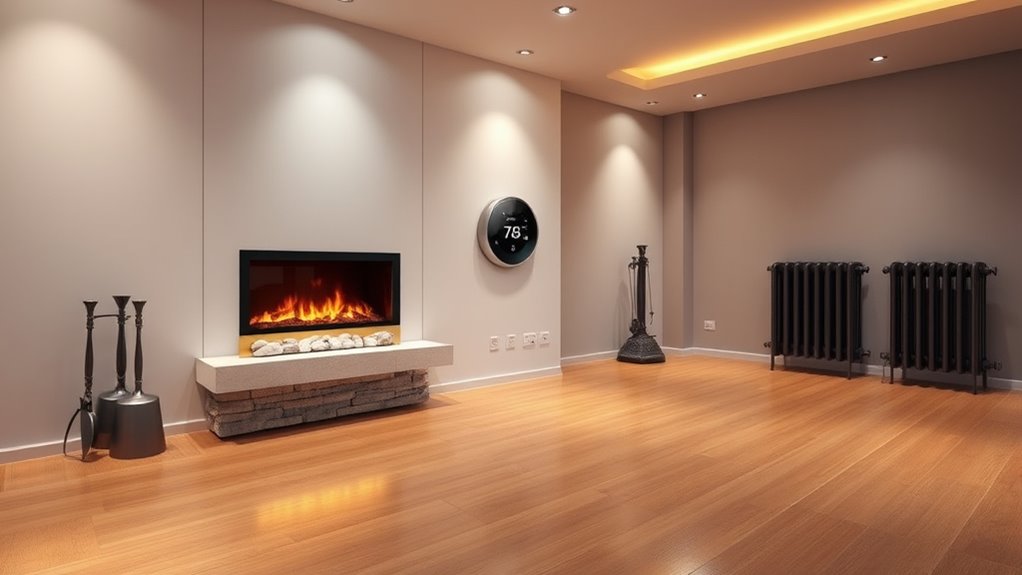
Electric heating technologies revolutionized home comfort by offering efficient and cleaner alternatives to traditional methods. Advances in energy efficiency mean you can heat your home with less power, saving money and reducing environmental impact. Additionally, crochet styles for locs allow for creative expression and customization, making modern heating systems not only practical but also adaptable to individual preferences. Plus, modern systems give you greater convenience and control, letting you customize your indoor climate easily.
Electric Heating Technologies
Have you ever wondered how electric heating transformed home comfort in the modern era? It revolutionized heating by offering cleaner, more efficient options. Imagine:
- Radiant electric panels warming your walls evenly
- Baseboard heaters quietly providing consistent heat
- Solar panels powering your home’s electric needs sustainably
- Geothermal systems harnessing underground heat for ultra-efficient warmth
Electric heating technologies became more accessible as advancements allowed integration with renewable sources like solar panels, reducing reliance on fossil fuels. Geothermal systems, although initially costly, now complement electric systems by providing a stable, eco-friendly heat source. These innovations made home heating more reliable, customizable, and environmentally conscious, paving the way for smarter, energy-efficient solutions in today’s homes. Additionally, natural techniques such as organic insulation materials and energy-efficient design practices further enhance the sustainability of modern electric heating systems.
Energy Efficiency Advances
As home heating systems have become more advanced, a key focus has shifted toward maximizing energy efficiency. Modern innovations include integrating solar panels to harness renewable energy, reducing reliance on fossil fuels and lowering costs. Geothermal heating systems tap into the steady underground temperatures, providing efficient, sustainable warmth year-round. These technologies work together to minimize energy waste and lower your home’s carbon footprint. Electric heating, once considered less efficient, now benefits from advancements like heat pumps that leverage geothermal energy. By combining solar power with geothermal heating, you can considerably cut energy bills and contribute to environmental conservation. Additionally, understanding how to identify bad lemon juice can help ensure you use only fresh ingredients, supporting overall health and safety. These developments mark a pivotal shift toward smarter, greener home heating solutions that prioritize efficiency without sacrificing comfort.
Convenience and Control
Thanks to advances in technology, modern home heating now offers unprecedented levels of convenience and control. You can adjust your thermostat from anywhere using remote access, ensuring your home is cozy when you arrive. Imagine:
- Setting personalized schedules that match your daily routines
- Monitoring energy use through intuitive apps
- Receiving alerts if temperatures drop unexpectedly
- Seamlessly switching between different heating zones with a tap
These features put you in charge of your comfort and efficiency. You no longer need to get up to manually adjust a thermostat or worry about wasting energy. Instead, you have precise control at your fingertips, making home heating smarter, easier, and more tailored to your lifestyle. Additionally, integrating efficient general ledger coding can help manage energy expenses more effectively.
The Development of Modern HVAC Technologies
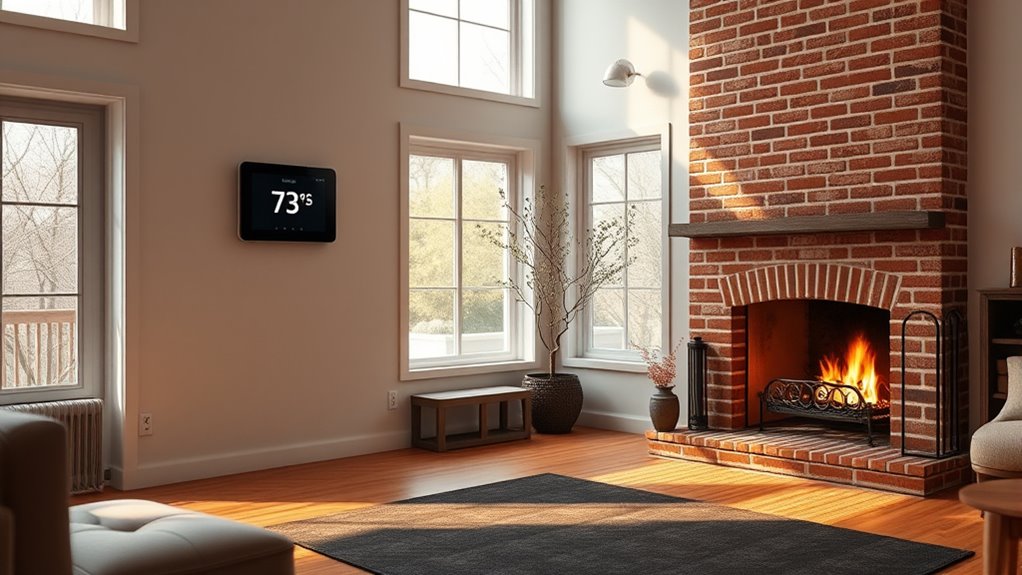
The development of modern HVAC technologies has revolutionized how we control indoor climate, making it more efficient, reliable, and comfortable than ever before. Today’s systems emphasize sustainable heating by integrating renewable energy sources like solar and geothermal power. These innovations reduce reliance on fossil fuels, cutting emissions and lowering energy costs. Advanced heat pumps and high-efficiency furnaces optimize performance while minimizing environmental impact. Modern HVAC systems also feature better insulation, zoning capabilities, and intelligent controls that enhance energy use and indoor comfort. As a result, you benefit from consistent temperatures, lower utility bills, and a smaller carbon footprint. This evolution reflects a shift toward environmentally conscious solutions, ensuring that home heating remains effective and sustainable for generations to come. Additionally, innovations like smart thermostats and energy-efficient heating devices contribute to smarter, more adaptive climate control.
The Advent of Smart Thermostats and Automation
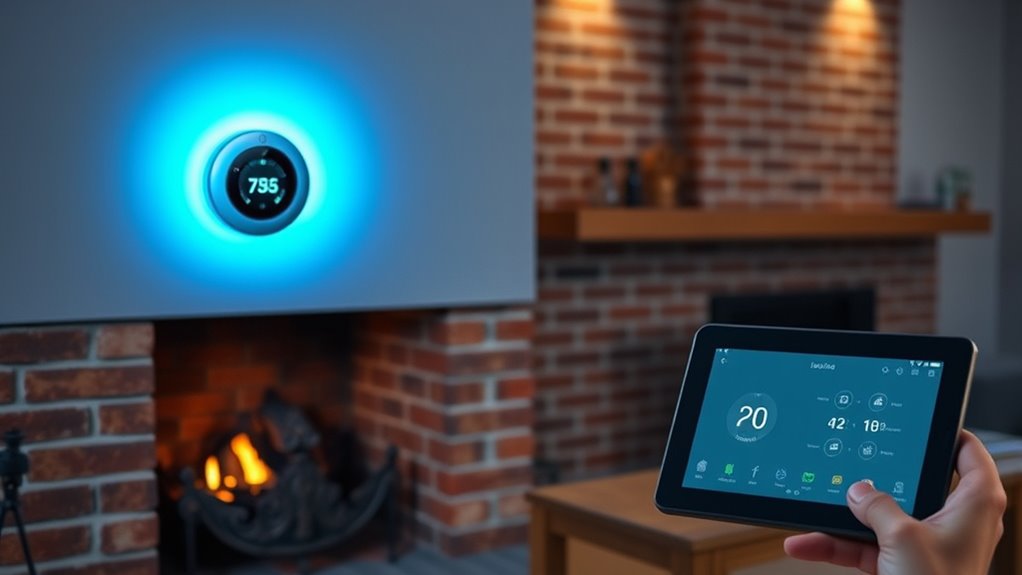
Smart thermostats and automation have transformed home heating by giving you greater control and convenience. Now, you can adjust your home’s temperature with just voice commands or remote control, no matter where you are. Imagine walking into your house and saying, “Set the temperature to 70 degrees,” or using an app on your phone during your commute. Visualize the following:
Control your home temperature effortlessly with smart thermostats—voice commands, remote access, and intelligent scheduling for ultimate comfort.
- A sleek thermostat on your wall, learning your schedule.
- Your voice activating the system effortlessly.
- Remote control adjustments from your tablet or smartphone.
- The system intelligently adapting to your habits, saving energy and money.
With these innovations, you’re no longer bound by manual thermostats; instead, you enjoy seamless, personalized comfort at your fingertips.
Future Trends in Home Heating

As technology continues to evolve, future home heating systems are expected to become even more efficient, sustainable, and integrated with daily life. You’ll see a shift toward using renewable sources like solar, geothermal, and wind energy, reducing reliance on fossil fuels. These systems will prioritize sustainable design, combining energy efficiency with eco-friendly materials and construction methods. Smart technology will play a bigger role, allowing you to manage heating more precisely and remotely, optimizing energy use and lowering costs. Integration with home automation will ensure seamless operation, adjusting heat based on your habits and weather conditions. Overall, future home heating will focus on reducing environmental impact while providing comfort and convenience, aligning with global efforts to combat climate change and promote sustainability.
Frequently Asked Questions
How Did Ancient Civilizations Heat Their Homes Before Fireplaces?
You might wonder how ancient civilizations heated their homes before fireplaces. They used ancient heating techniques like stone and clay structures that trapped heat, and often relied on prehistoric fire making to generate warmth. Some built central hearths or used body heat and insulation to stay warm. These methods were simple but effective, helping early humans survive cold weather long before modern heating systems emerged.
What Materials Were Traditionally Used in Early Heating Systems?
You’d find that early heating systems used materials like stone, clay, and brick for insulation, helping retain heat. They relied on heating fuel types such as wood, coal, and dung, which were burned in simple hearths or rudimentary stoves. These materials and fuels created the foundation for more advanced systems, enabling civilizations to keep homes warmer and more comfortable with the technology available at the time.
How Did the Industrial Revolution Impact Home Heating Technology?
During the industrial revolution, you see significant strides in home heating technology. Industrial innovations ignited rapid advancements, making heating more efficient and accessible. Technological advancements transformed traditional methods, introducing new fuels, central heating systems, and radiators that radiate warmth throughout homes. You benefited from better heat distribution, increased convenience, and improved safety, all driven by the dynamic developments of this era, revolutionizing how you stay warm during cold seasons.
Are There Eco-Friendly Alternatives to Traditional Home Heating Methods?
You’re probably wondering if eco-friendly alternatives to traditional home heating exist. Yes, you can use solar panels to harness renewable energy, reducing your carbon footprint. Geothermal heating taps into the Earth’s natural warmth for efficient, sustainable warmth year-round. These options not only cut your energy bills but also help protect the environment, making your home more sustainable and eco-friendly.
How Do Smart Thermostats Improve Energy Efficiency and Savings?
Smart thermostats are like a personal energy detective, tracking your habits to optimize comfort and efficiency. They reduce your home’s energy consumption by learning your schedule and adjusting heating or cooling accordingly. This targeted approach leads to significant cost reduction, helping you save money on utility bills. With remote control options and programmable settings, you stay in charge of your energy use, making your home smarter and more eco-friendly.
Conclusion
While it might seem simpler to stick with traditional heating methods, embracing modern technology can make your home more comfortable, efficient, and even save you money. Don’t let the idea of change hold you back—think of the warmth and peace of mind a smart thermostat can bring. By upgrading, you’re not just improving your home’s comfort, you’re investing in a smarter, more sustainable future for yourself and your loved ones.



